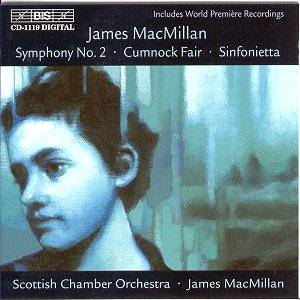James MACMILLAN (born 1959)
Sinfonietta
Cumnock Fair
Symphony no. 2
 Scottish Chamber Orchestra/James
MacMillan
Scottish Chamber Orchestra/James
MacMillan
Rec February 2000, City Hall, Glasgow
 BIS CD1119 [55.52]
BIS CD1119 [55.52]
Crotchet
AmazonUK
AmazonUS
Amazon
recommendations

James MacMillan is now established as one of the leading composers of our
time, a position which this excellent CD does much to confirm. His output
is impressive in both its range and its quality and he has worked closely
with the country's leading musicians, orchestras and opera companies,
particularly in his native Scotland.
Born in Ayrshire in 1959, MacMillan studied at Edinburgh and Durham universities
and first came to public attention in the late 1980s, when he also developed
a strong creative relationship with the Scottish Chamber Orchestra, with
whom he became Affiliate Composer in 1990.
Although this recording is not new, the Sinfonietta remains fresh
and direct. It was written for the London Sinfonietta, but the Scottish Chamber
Orchestra play it with a commitment which suggests they have known the music
for years. If that may not be so, they do at least know the composer well,
since they have shared a close musical relationship for some time. It shows.
The performance is exciting and makes the most of the wide-ranging moods
contained within the twenty-minute time-scale. The BIS recording, powerful
yet natural, also serves the music well.
Cumnock Fair is an attractive folk-based composition which
shows that musical nationalism is alive and well. MacMillan lived in the
small town of Cumnock as a boy, so there is an element of nostalgia here
too. The mood is generally lively, though at the heart of the piece lies
an introspective interlude which shows another aspect of the composer's technique
and personality. Here and elsewhere Ronald Weitzman's sensitive insert note
allows us to gain insight into the procedures and priorities involved in
creating the music.
The recent Second Symphony (1999) is not much larger than the Sinfonietta.
It has three movements, the outer of which are brief in the manner of prelude
and postlude, and contain material which is germane to the whole. The scoring
is lighter and more sophisticated than in the Sinfonietta, while the structure
is complex and varied, never settling into the routine of a single dimension
or tempo. But in every way the music abounds in subtleties, which the excellent
recorded sound allows their full rein. In fact the music is not entirely
new. Like so many composers before him, MacMillan is engaging in parody,
the technique of reworking existing music into a new identity. In this case
the source is a piano sonata which predates all the music contained in this
collection, though the new context gives it both a new manner and a new
conviction.
Terry Barfoot

